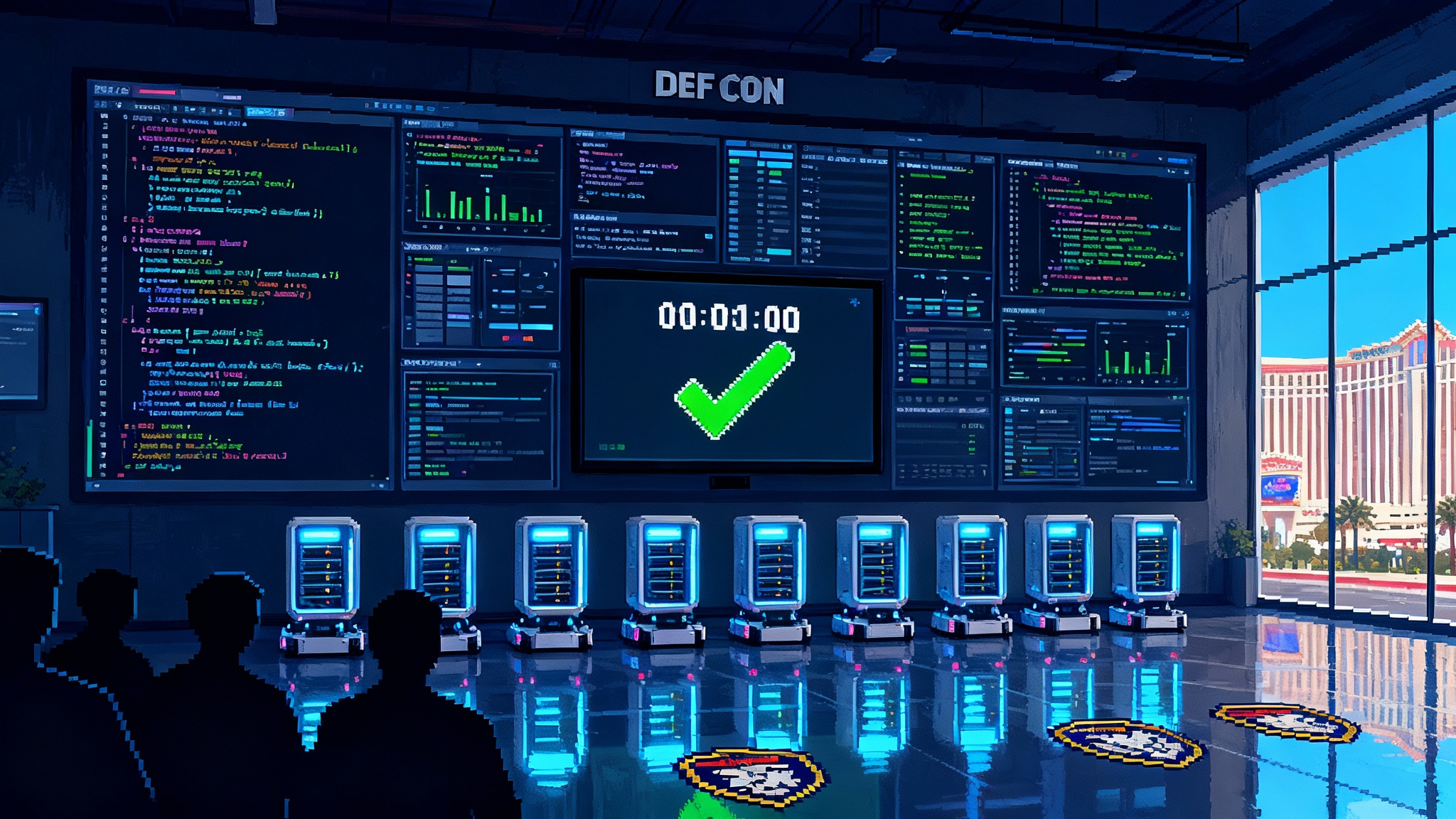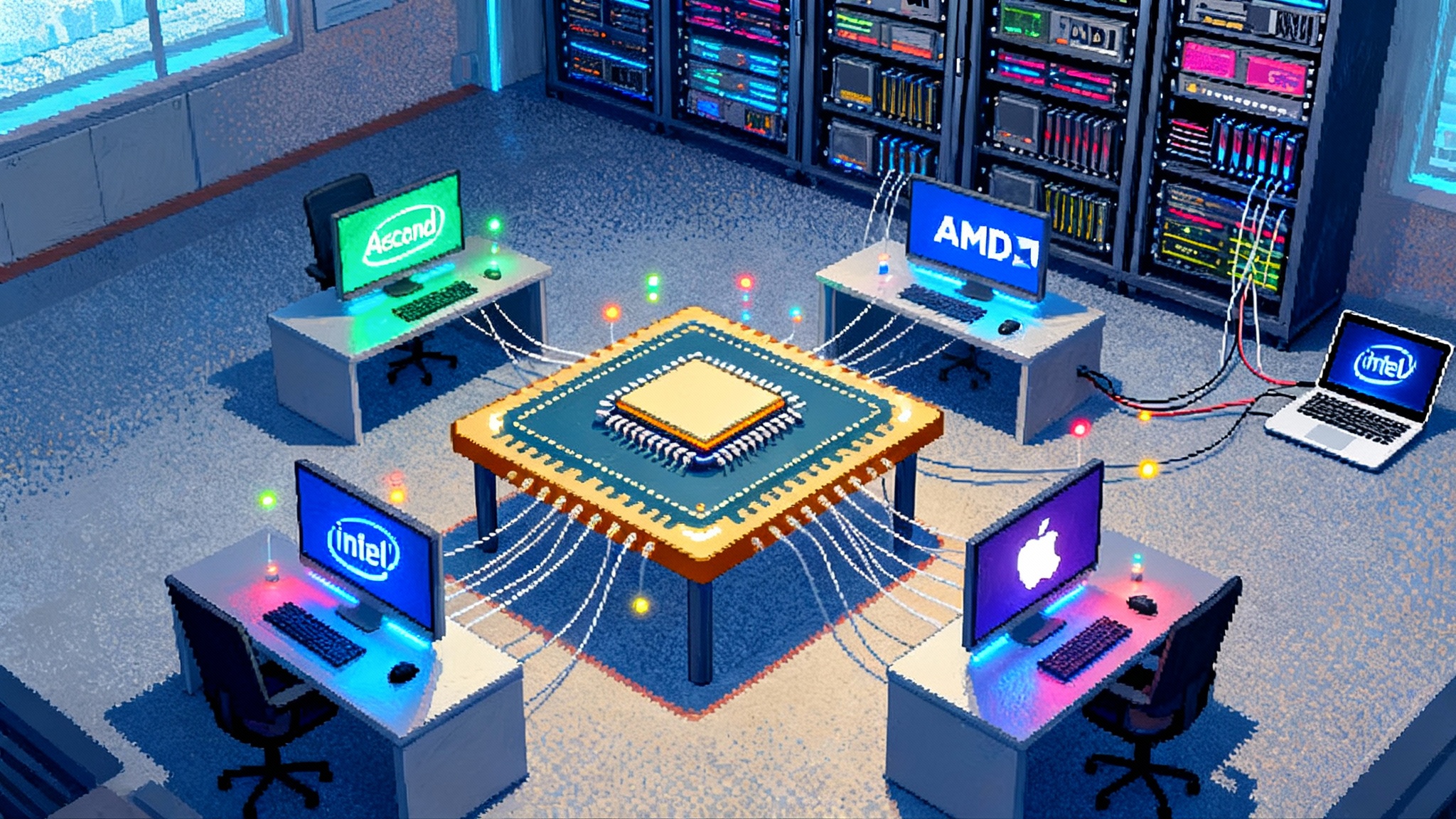The Day Software Learned to Patch Itself at DEF CON 33
At DEF CON 33, autonomous systems found and fixed real vulnerabilities in minutes. This piece unpacks the ATLANTIS blueprint, Proof-of-Patch, and why MTTP is about to become a board metric for modern security.

The moment the patch button pressed itself
On August 8, 2025, inside a packed hall at DEF CON 33 in Las Vegas, DARPA announced that Team Atlanta had won the AI Cyber Challenge. What mattered most was not the trophy. It was the demonstration that fully autonomous systems could find and fix real software vulnerabilities across tens of millions of lines of code, at competitive speeds and costs, while humans watched from the balcony. The public summary captured the scale: teams analyzed more than 54 million lines, discovered 54 synthetic flaws and patched 43 of them, and even surfaced 18 real, previously unknown issues in widely used projects. Patches were often submitted in minutes, with an average cost per task around 152 dollars, and four teams produced one-line fixes that nonetheless closed real holes. The results were immediate, public, and open source. The pitch was simple and radical. Security can be automated end to end. The details are laid out in DARPA’s finals wrap, which reads like a line being crossed rather than a prize being claimed: AI Cyber Challenge marks pivotal inflection point.
If you work in software, you felt it. Overnight, patching looked less like a quarterly compliance chore and more like air traffic control. Instead of a release train trundling along, we saw a continuous stream of potential incidents, candidate fixes, and safety checks negotiating for runway slots, all orchestrated by machines that never sleep.
From products to processes, and from cycles to negotiation
For decades, defense meant buying products. You deployed a scanner, a firewall, a set of rules. The cadence was human. You waited for the next release, the next advisory, the next Tuesday. In Las Vegas, defense looked different. It was a living system in motion. Autonomous agents probed code, constructed proofs that the bug was real, generated a patch, verified it against tests, and pushed a fix into a controlled environment while a scoring harness measured speed and correctness. Humans set guardrails and wrote policies, but the gameplay unfolded at machine speed.
Think of it as a negotiation between two swarms. On one side, red automation continuously explores program states, fuzzes inputs, and tries weird corners. On the other, blue automation triages signals, proposes candidate patches, and runs test batteries to keep functionality intact. The negotiation is fast and adversarial, but it is also procedural. The systems exchange evidence. They create artifacts. They keep receipts.
That last point matters. When machines patch code, the question is not only whether they are right. It is whether anyone can prove it later.
The ATLANTIS blueprint
In September 2025, the Team Atlanta group published a technical report on ATLANTIS, the system that won the finals. The paper is a map of what modern autonomous defense looks like under the hood: large language models directing symbolic execution, directed fuzzing feeding candidate traces, static analysis pruning false positives, and a repair loop that drafts patches and tests them against behavioral oracles and unit suites. The authors emphasize two themes that deserve board-level attention. First, speed is not only about faster models; it is about orchestrating many specialized engines with clean handoffs. Second, correctness is a pipeline property; tests, canaries, and rollbacks are as crucial as the patch text. The architecture and rationale are worth a close read in the ATLANTIS technical report.
The headline results from the finals explain why this approach works. If a system can propose a patch within roughly 45 minutes on average, and the surrounding harness can validate that patch with differential tests and basic behavioral checks, you can shrink the exploitable window from weeks to minutes. Even when a patch needs further human review, the work arrives pre-triaged with a reproducible test and a candidate fix. Human talent shifts from searching for the bug to verifying and shepherding a near-ready change.
What changes when machines write the fixes
This shift is not just an engineering upgrade. It reorders responsibility, audit, and economics.
-
Code provenance for machine-generated fixes. Every autonomous patch should carry a provenance trail, not only the commit author. A robust trail includes the diff, the test that proves exploitability, the test that proves the fix, the versions and hashes of tools used, the model identifier and weights digest, the prompt template or policy file, the training data license claims where applicable, and the environment metadata that might influence nondeterminism. This looks a lot like a modern software supply chain dossier. It can reuse the ingredients that development teams already understand: a software bill of materials for changed dependencies, a vulnerability exploitability exchange note that ties a fix to a flaw, and a signed attestation that binds the parts. If you care about verifiable origin, the mindset rhymes with how content credentials win the web. Two years from now, an auditor should be able to replay the decision, rerun the tests, and reach the same judgment.
-
Liability and insurance when a patch backfires. Today, model licenses, platform terms, and traditional software warranties point responsibility in different directions. When an autonomous patch causes an outage, three parties have skin in the game: the operator who applied it, the vendor whose software was patched, and the model or autonomy provider who authored the fix. Insurers will not wait for courts to draw perfect lines. Expect policies to add endorsements that require minimum evidentiary standards before coverage applies, for example a signed proof-of-patch bundle, a canary deployment record, and automated rollback within a stated time threshold if monitors fire. Vendors can earn safe harbor treatment when they accept machine-authored fixes that meet a documented quality bar and pass a standard regression suite. Model providers can offer performance warranties tied to specific risk classes, such as input validation or memory safety, with limits and exclusions spelled out.
-
MTTP becomes a board metric. Mean time to patch is different from mean time to detect or mean time to recover. It measures how quickly the organization transforms a confirmed vulnerability into a deployed fix, at scale. Autonomous defense makes MTTP visible and actionable. Leaders can track MTTP by severity, by product line, and by environment. They can demand percentile targets, for example P90 within 120 minutes for internet-facing services and 24 hours for offline devices, with variance allowances for safety-critical systems. They can tie incentives to MTTP reductions that do not increase regression rates. And they can cross-check MTTP against exploit telemetry to confirm that windows are truly closing.
Proof-of-Patch: not just a signature, a case file
If defense becomes a continuous game, evidence is the rulebook. That is why a standardized Proof-of-Patch attestation is the natural next step.
A good Proof-of-Patch should answer seven questions in one portable package:
-
What changed, exactly? Include the diff, target versions, and build metadata.
-
What vulnerability does it close? Include a linkable identifier, a machine-readable description of preconditions, and the failing exploit proof.
-
How was the fix tested? Attach deterministic unit tests, an input corpus, and any harness used to measure behavior and performance.
-
Who or what authored it? Record the toolchain with digests, model versioning, prompts or policies, and the identity of the orchestrator.
-
How was risk managed in rollout? Include canary scope, shadow traffic results, and rollback gates.
-
How can a third party recheck it? Provide commands and scripts to replay analysis in an isolated environment.
-
Who signed off? Bind cryptographic signatures from the autonomy system and any human approver in the chain.
With that bundle in hand, an enterprise can automate acceptance. Security operations can write policies such as: allow emergency patches that close remote code execution in internet services if they carry a complete, valid Proof-of-Patch and pass a 30 minute canary with no error rate drift beyond 0.2 percentage points. Audit can sample the same artifacts. Insurers can require them for claims. Regulators can reference the format in directives and rulemaking. For teams building trust boundaries, the idea aligns with how confidential AI with proofs elevates evidence to a first class requirement.
What to mandate, and why to do it now
North American critical infrastructure already runs on compliance frameworks that encode controls, but they do not yet encode speed. To bend exploit windows from weeks to minutes, policymakers can do three concrete things.
-
Require baseline autonomous defense in regulated sectors. For operators covered by federal directives in energy, healthcare, transportation, and water, set minimum autonomy requirements for code scanning, patch drafting, and canary deployment. The rule should not force a vendor. It should force a capability: an operator must demonstrate that authenticated automation can triage a critical flaw and stage a candidate fix within a fixed time budget, with a human on the loop before production promotion.
-
Standardize Proof-of-Patch attestations and registries. Publish an open schema for Proof-of-Patch and require that covered entities store these attestations in a transparency log. Encourage public maintainers to accept such artifacts for fast track reviews. Build trust roots so that signatures from approved autonomy systems and platform build pipelines can be verified at scale.
-
Make MTTP a reportable key performance indicator. Mandate quarterly MTTP reporting for covered entities, broken out by severity, internet exposure, and environment type. Create staged targets that ratchet down over time. Tie incident disclosure relief to demonstrated MTTP performance so that organizations that move quickly and safely are recognized.
These moves are accelerationist, and that is the point. Attackers do not wait for working groups. The best way to keep pace is to make speed a measured requirement, not an aspiration.
How to adopt autonomous defense without breaking things
Boards will ask the obvious questions: Will this cause outages, and who is accountable? The answer is to start with a controlled, testable footprint and grow from there. A practical rollout plan looks like this.
-
Pick three fast moving services as your beachhead. Instrument them with high quality tests, error budgets, and canary pipelines. If your tests are thin, invest there first.
-
Stand up an autonomy orchestrator as a separate service with its own identity and keys. Limit its privileges to staging branches and pre production environments. Log everything.
-
Define your Proof-of-Patch template and rejection reasons. If an autonomy system cannot produce a matching exploit and a passing regression, reject the fix by policy.
-
Start in shadow mode. Let the autonomy system produce patches that go through tests and canaries but never reach production. Track MTTP to see the raw potential and track how often a human reviewer would have rejected the change.
-
Move to supervised promotion. Allow production promotion for a narrow, well defined class of issues, for example input validation and denial of service fixes, with rapid rollback if monitor thresholds are crossed.
-
Publish your early artifacts. Share sanitized Proof-of-Patch bundles with your suppliers and peers. Ask them to integrate, critique, and iterate with you. You will learn faster, and you will help your ecosystem upgrade together.
Over six to twelve months, this path lets you convert a slogan into a procedure. By the time you extend autonomy to more complex fixes, your test coverage, monitoring, and rollback hygiene will be in a stronger place.
The red team does not disappear; it multiplies
It is tempting to read August 2025 as the end of the attacker advantage. That would be a mistake. Machine paced defense invites machine paced offense. Adversaries will try to poison training data, craft inputs that fool repair loops, or bait autonomy into creating patches that hide deeper faults. Some will build their own repairers to speed up exploit chains. Expect red automation to mutate as quickly as blue.
The defense is to keep the negotiation honest. Require exploit proofs before fixes. Separate fuzzing corpus storage from build systems. Randomize test inputs to discourage overfitting. Run static and dynamic checks that look for suspicious patterns in patches, such as bypasses that silence errors without addressing root causes. Maintain a small library of known bad patches and test that your autonomy system refuses them. And watch the metrics that matter. If MTTP improves but regression rates climb, your negotiation is out of balance.
Platform hooks and the agentic edge
Cloud providers and enterprise platforms will add native support for autonomy identities, attestation storage, and policy enforcement. Expect built in toggles such as allow emergency autonomy for defined classes of flaws with time limited elevation and automatic rollback. As these hooks spread to browsers and endpoints, the line between runtime and remediation will blur. That shift connects to a broader trend where the agentic browser era pulls more decision making into the edge of the network.
What matters for teams is that autonomy becomes a first class user of your platform. It needs clear identities, signed requests, scoped privileges, and observable behavior. Treat it like a new kind of engineer that never sleeps, never merges without a ticket, and always attaches a case file.
The economics get interesting fast
The finals hinted at a new cost curve. If a team can analyze complex code and submit a patch in under an hour at an incremental cost on the order of a few hundred dollars, the economics of software security shift. Bug bounty programs will still matter, but some classes of bugs will become cheaper to prevent than to hunt. Internal security teams will ship more tooling and fewer reports. Vendors will compete on evidentiary quality and performance guarantees rather than on gates and checklists.
Procurement will follow. Buyers will ask suppliers for Proof-of-Patch support, model version transparency, and published MTTP reports. Insurers will discount premiums when telemetry shows that exploit windows close faster than threat actor playbooks can pivot. Regulators will ask whether an operator has demonstrated autonomy in an exercise, not only whether they own a tool.
What to watch next
-
Repeatability in the wild. The finals were a controlled environment. Watch how quickly maintainers accept machine authored fixes in public repositories and how Proof-of-Patch bundles evolve to meet real world review needs.
-
Platform hooks. Cloud providers and enterprise platforms will add native support for autonomy identities, attestation storage, and policy enforcement. Expect built in toggles such as allow emergency autonomy on defined classes of flaws with time limited elevation and automatic rollback.
-
Safety improvements beyond tests. Better semantic equivalence checks, model based explanations for why a fix is safe, and autotuned canary thresholds that learn service baselines.
-
Legal contours. The first policyholder disputes involving autonomous patches will arrive. They will be messy. The winners will be the organizations that kept clean provenance and clean rollbacks.
The pivot, in one sentence
The finals at DEF CON 33 and the ATLANTIS paper did not just show that software can patch itself; they showed that defense can be treated as a living, continuous negotiation, where speed, evidence, and accountability are the currencies. That is a future worth choosing on purpose.
A smart close
The industry has waited for a proof that autonomy can act, not just advise. August and September 2025 delivered it. The right next move is not to debate whether machines should patch code, but to decide how we will prove that their patches are correct, reversible, and fast. If we mandate baseline autonomy for critical infrastructure, standardize Proof-of-Patch attestations, and elevate MTTP to a board metric, we can bend global exploit windows from weeks to minutes. That is not a slogan. It is an implementation plan that starts with one service, one policy, and one signed bundle that says, here is the fix, here is the evidence, ship it.







